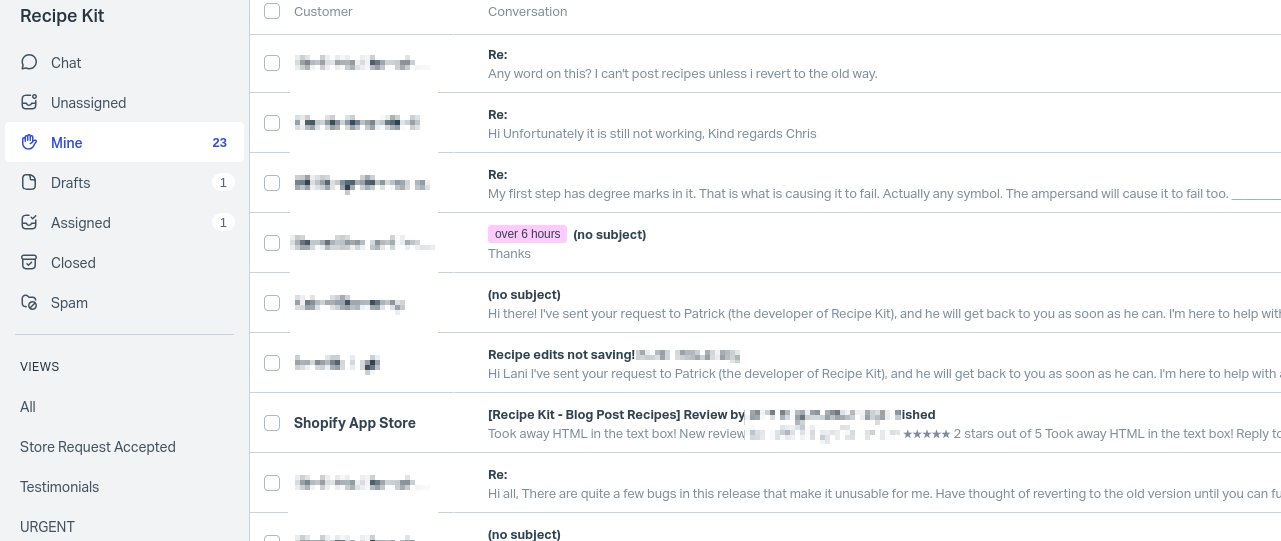A catastrophic launch, documented
I spent six months rebuilding Recipe Kit from the ground up, then deployed it to 2,000+ stores simultaneously. It did not work out well.

You know that moment when you're about to hit "deploy" and there's this little voice in your head saying "maybe wait another day"?
I should have listened to that voice.
Instead, I pushed a massive infrastructure update to my Shopify app Recipe Kit live to 2,000+ Shopify stores and promptly watched my support inbox blow up with angry customer complaints and bug reports.
The Setup: Why I Decided to Rebuild Everything
Recipe Kit launched in 2020, but its DNA goes back to 2017 when I built my first app, Wait.li. Back then, I was Googling "what is a webhook" and copying code snippets from Stack Overflow. The foundation was a very shoddy Vue.js app, held together with duct tape and tons of spaghetti code.
For years, it worked. Merchants loved it. They built extensive recipe blogs on their Shopify stores, drove traffic, converted browsers into buyers. But under the hood? It was a house of cards.
Shopify evolved. Polaris landed. App Bridge was released. My little Vue app was stuck in 2018, and it felt like it - while new apps were being released with state-of-the-art features, Recipe Kit's infrastructure made it very difficult to keep up with the trends and competitors.
So I made the call: complete rebuild. React, modern infrastructure, the works.
Six months later, I had something beautiful. Recipe Kit v2 is amazing, it's everything I wanted in the app from day one. We're talking advanced analytics that show merchants exactly how much revenue their recipes generate. More detailed recipe sections that make recipes more complete. An SEO scoring algorithm that analyzes recipes and suggests improvements to climb Google search rankings.
This is more than an upgrade. It is Recipe Kit becoming more than just a recipe card plugin, turning the app into a commerce platform to build your CPG food brand on top of.
Mistake #1: Lack of Communication
A month before launch, I fired off an email to every customer: "Big update coming next week! Here's what's changing!"

Screenshots, feature previews, the full hype machine. Everyone told me this was needed. Build anticipation, get people excited, and warn them of a change in their workflow.
The problem? "Next week" turned into five weeks with no updates.
Software development timelines are more or less fiction in my experience, and I learned this the hard way. Every day past my promised date, customers pinged support: "Where's the update?" "When is this launching?"
That steady drip of disappointed emails hurt more than I expected. These aren't just users. They're small business owners juggling a million things, trusting me to deliver when I say I will.
The fix? Radical transparency. Next time, you'll get progress videos, live Q&As, and honest "here's why we're delayed" updates. No more fake timelines built on wishful thinking.
Mistake #2: Testing in a Bubble That Wasn't Reality
I spent weeks hammering the app staging environment with test scenarios. I pulled live production data, simulated heavy loads, clicked every button until my fingers went numb.
Everything looked perfect. Recipe imports worked flawlessly. Analytics dashboards loaded instantly. The new equipment sections rendered beautifully.
Then I went live.
Immediately, the bug reports started flooding in. Recipes wouldn't save. Sessions kept timing out. Edge cases from five years of real-world usage broke things we never even considered testing.
The worst part? These weren't minor hiccups. Core functionality was broken. Merchants couldn't create recipes. Their existing content wouldn't load. The very features that make Recipe Kit valuable just didn't work.
One particularly brutal moment: A major Plus store that had been with us for 4+ years dropped their 5-star review to 2 stars. That review change hit like a physical punch. It felt like I shattered the trust I'd built through all these years.
The lesson stings because it's so obvious in hindsight: staging environments can't replicate the chaos of real customer workflows. I needed beta testers, gradual rollouts, and contingency plans for when things went sideways.
Mistake #3: The Nuclear Option (AKA Rolling Out to Everyone at Once)
Here's where my lack of engineering background really showed.
Most SaaS companies do gradual rollouts. Feature flags. A/B testing. Roll out to 5% of users, then 25%, then 50%, with kill switches ready if things break.
I didn't do any of that.
Since v2 was a complete infrastructure change - new servers, new databases, everything - I convinced myself that gradual rollouts weren't possible. The old version lived on one server, the new version on another. How do you gradually migrate between completely different systems?
Turns out, there are ways. DNS routing, load balancers, proxy servers. I just didn't know they existed, so I took the nuclear option: flip the switch for everyone at once.
2,000+ stores moved to the new system simultaneously. When bugs hit, they hit everyone. It was sink or swim, and I was definitely sinking.
The worst part was my ego didn't allow me to pull the trigger to revert to the old version until 36 hours later when customers starting to get really angry.
I need to learn better system-ops. It's complex, but the alternative - breaking everyone's workflow at once - is unacceptable.
The Humbling Reality Check
Here's the thing about being a solo founder: you don't know what you don't know. I've been freelancing my entire career - 10+ years of building and launching everything myself. No team, no code reviews, no senior dev to tell me I'm being an idiot. That approach usually worked fine, sometimes I'd mess up but I was always on the ball to fix it.
All those best practices I skipped weren't things I consciously ignored—they were blind spots I didn't even know existed.
Underestimating Recipe Kit's Value
For years, I've minimized Recipe Kit's importance in my own mind. "It's just a recipe app," I'd think. "If it goes down for a day, stores can manage - it'll be fine"
This rollout shattered that delusion.
Recipe Kit isn't just a recipe card creator. It's the tool that small and large food brands use to build content that brings them (hungry) customers. It's about turning content into commerce, stories into sales. When Recipe Kit breaks, merchants lose their vehicle for content creation.
These Recipe Kit customers have supported me for years. They've paid my bills, funded my lifestyle, and trusted me with a piece of their business. The fact that my careless rollout disrupted their operations feels like betraying that trust.
But there's something beautiful in this mess too. The support emails weren't just complaints. They were detailed bug reports, feature suggestions, and expressions of hope that we'd fix things quickly. These merchants care about Recipe Kit because it actually moves the needle for their businesses, and that brings me a lot of joy.
What's Next
The immediate aftermath was brutal but necessary. Within 36 hours, I made the call I should have made from hour one: full revert to the old version. Every store, every customer, back to Recipe Kit v1.
Now comes the grinding part: I'm spending the next week rebuilding not just the technical rollout process, but the trust I damaged. Late nights debugging, early mornings responding to support tickets, and constant progress updates to prove that this disaster was an exception, not the new normal. It's humbling work, but it's exactly what my customers deserve after years of supporting my solo founder efforts.
This will start immediately with radically transparent public roadmaps, changelogs, update videos, more emails, and gradual release processes that respect customers' time and trust.
Grateful Despite The Lack of Sleep
Solo founding is weird. You celebrate victories alone and absorb failures personally. This rollout was definitely a failure, but it taught me something crucial: my customers aren't just users tolerating my product. They're partners invested in making it better.
It's all worth the lack of sleep.
